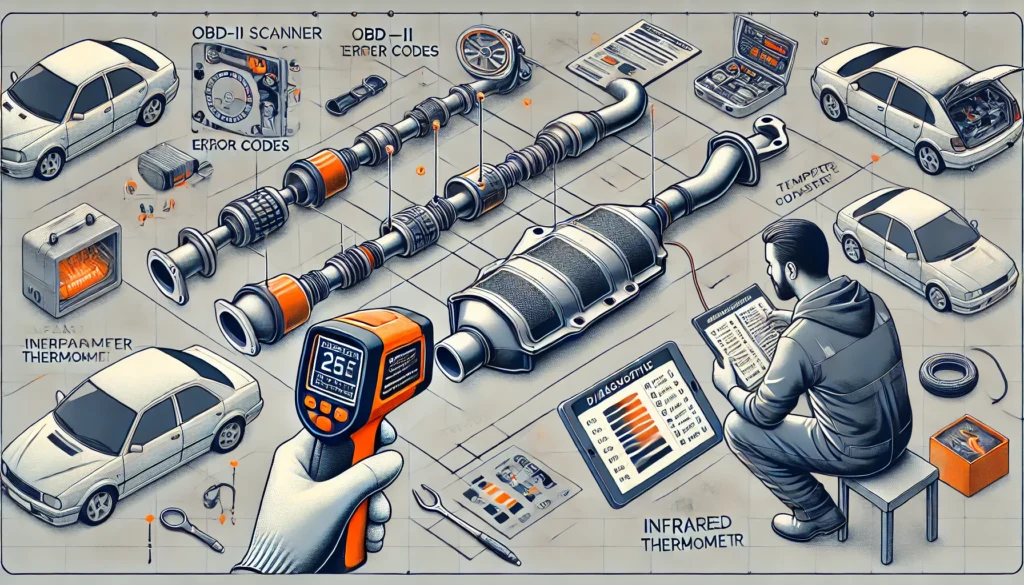The catalytic converter is a crucial component of your vehicle’s exhaust system, responsible for reducing harmful emissions. However, when it starts to fail, it can lead to a range of issues that affect your car’s performance and environmental impact. But How to Check a Bad Catalytic Converter? In this guide, we’ll explore the signs of a failing catalytic converter and the steps you can take to diagnose the problem accurately.

Recognizing the Symptoms of a Bad Catalytic Converter
Before you begin diagnosing a catalytic converter issue, it’s important to recognize the common symptoms:
- Check Engine Light
- The check engine light is often the first indicator of a problem with the catalytic converter. Modern vehicles have sensors that monitor the efficiency of the converter. If it’s not performing correctly, the check engine light will illuminate.
- Poor Acceleration
- A clogged or failing catalytic converter can restrict exhaust flow, leading to sluggish acceleration. If you notice a significant drop in your vehicle’s responsiveness, it could be a sign of a bad catalytic converter.
- Rattling Noise
- A rattling sound, especially during acceleration or startup, might indicate that the internal components of the catalytic converter are breaking apart.
- Dark or Black Smoke from the Exhaust
- If your vehicle is emitting dark or black smoke, it suggests that the catalytic converter is not effectively filtering exhaust gases.
- Sulfur or Rotten Egg Smell
- A strong sulfur smell from the exhaust is another sign that the catalytic converter is not working properly, as it’s not converting hydrogen sulfide into odorless gases.
Steps to Check a Bad Catalytic Converter
Now that you know the symptoms, here’s how you can check if your catalytic converter is bad:
1. Use an OBD-II Scanner
- An OBD-II scanner is the most straightforward tool for diagnosing catalytic converter issues. This device reads the diagnostic trouble codes (DTCs) stored in your car’s computer. Codes like P0420 or P0430 indicate that the catalytic converter’s efficiency is below the required threshold.
2. Perform a Temperature Test
- Using an infrared thermometer, measure the temperature at the inlet and outlet of the catalytic converter. A healthy converter should have a higher temperature at the outlet compared to the inlet, indicating that it is converting exhaust gases effectively. If the outlet temperature is the same or lower than the inlet, the converter might be clogged.
3. Conduct a Visual Inspection
- Examine the catalytic converter for any visible signs of damage, such as cracks, dents, or rust. Physical damage can impair the converter’s ability to function properly.
4. Exhaust Backpressure Test
- An exhaust backpressure test can help determine if the catalytic converter is clogged. High backpressure readings before the converter indicate that it is obstructed and may need replacement.
5. Listen for Unusual Noises
- Start your vehicle and listen for any rattling sounds coming from underneath. This noise could be a sign that the internal ceramic honeycomb structure inside the catalytic converter is damaged.
When to Replace a Catalytic Converter
If your diagnostic tests confirm that the catalytic converter is bad, replacement is often the only solution. Ignoring the problem can lead to more severe engine issues, failed emissions tests, and increased pollution.
Conclusion
Checking a bad catalytic converter involves recognizing the symptoms, using diagnostic tools like an OBD-II scanner, and performing tests such as temperature checks and backpressure tests. By following these steps, you can accurately diagnose catalytic converter problems and take the necessary actions to maintain your vehicle’s performance and emissions compliance.
